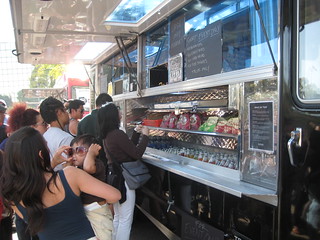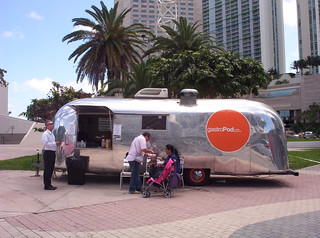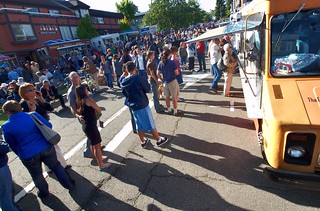Editor’s note: This article by PCJ contributing writer Beth Humstone supplements the PCJ article by Diana Limbach Lempel & Christina DiLisio, “Food Planning for Your Local Economy” (Winter 2012).
Across the country entrepreneurial chefs are peddling their food on the road — moving into parking spaces and serving up customers a broad range of culinary specialties at affordable prices. For many food truckers, this is a chance to try out their recipes, get a following, and move up to a bricks and mortar location someday. For others, it is a way to increase awareness of their anchor restaurants by spreading out into the community to broaden their base.
Food trucks have become so established that Zagat’s, the guide to fine dining, offers an interactive food truck finder for some cities. In Columbus, Ohio vendors have their own web site — Street Eats Columbus. The Mayor of Tampa, Florida, likes what food trucks do for his town and is organizing a monthly Food Truck Fiesta.
Truck outfitters, depot kitchens owners, website designers, lawyers, permit expediters, and marketers are all benefiting. Even established restaurant chains like Taco Bell and Jack in the Box are getting into the act. The industry is serviced by its own website, magazine, podcast series, and a show on the Cooking Channel. It looks like food trucks are here to stay.
 Many cities are embracing the rise in food trucks as a way to add jobs, bring vitality to the streets, and offer convenience and diverse eating choices to consumers. Yet others have resisted the trend when faced with angry push-back from established restauranteurs who say the trucks are unfair competition and block views of their businesses.
Many cities are embracing the rise in food trucks as a way to add jobs, bring vitality to the streets, and offer convenience and diverse eating choices to consumers. Yet others have resisted the trend when faced with angry push-back from established restauranteurs who say the trucks are unfair competition and block views of their businesses.
Opponents complain that the mobile vendors aren’t tax-paying, rent-paying, ADA-compliant, health-inspected, and zoning-permitted businesses. While food truck vendors may not pay rent or property taxes, they do incur costs for food, food preparation and storage, fuel, permits and fees, and truck maintenance. They also usually must meet a host of local regulations.
Many communities require health inspections, vending permits, business registration, and zoning permits. Still others, such as St. Petersburg, Florida, don’t permit mobile food vendors at all. Pressures are mounting, however, for cities to loosen up their restrictions on food trucks. Courts have struck down zoning standards on food trucks designed to address unfair competition with bricks-and-mortar restaurants. Support from the business community and even other restauranteurs is beginning to grow — provided some conditions are met.
What are the considerations that planners must make with respect to food trucks to respond to this mobile land use issue?
Definition: Food trucks are distinct from push carts, trailers (towed carts), and other retail vendors. They are motorized vehicles with on board power, refrigeration, food preparation facilities, and usually room for two to four employees.
Location: Local rules on where food trucks are permitted vary across the country. Some are restricted to private property, others to public property. Some communities ban food trucks altogether. Others only allow them to stop when a customer flags them down.
 On private property. Parking of food trucks on private property may be subject to zoning approval if a community has identified mobile food vendors as an allowed use and specified where they may go. If food trucks are not mentioned, regulations will either have to be amended or special permits issued to allow them in the community.
On private property. Parking of food trucks on private property may be subject to zoning approval if a community has identified mobile food vendors as an allowed use and specified where they may go. If food trucks are not mentioned, regulations will either have to be amended or special permits issued to allow them in the community.
On public property. In some communities food trucks use metered parking spaces or public lots and pay the hourly rates. This practice has angered local merchants who claim that they are tying up valuable customer parking spots. As a result, some cities, including New York, have banned food carts from metered spots. Others have allowed food trucks to use public spaces, but have limited the days, hours, and locations where they are allowed. For example, the City of Seattle, which had not previously allowed food trucks on its streets, is now proposing that food trucks using public parking spaces pay $2.25 an hour for up to four hours of parking per week for a total of $468 per year. The City will use a lottery system if more than one vendor seeks to locate at the same spot.
Distance to restaurants. To address the concerns of brick-and-mortar restaurants about competition from food trucks, some communities limit vendors to a minimum distance from existing restaurants. An ordinance has been introduced in Chicago to force trucks to park at least 200 feet from restaurants and 100 feet from retail stores that sell food. However, there may be limits to how far cities can go. When a lawsuit was filed against El Paso, Texas, for its 1,000 foot restrictions, the city dropped this provision.
Totally mobile. Some cities, such as Washington, D.C., still regulate food trucks under antiquated ice cream truck regulations that only allow the vendors to stop when customers flag them down. Through use of social media, customers can congregate in a location and then notify the food truck of their presence. The food truck then must find a legal parking space nearby in order to serve the customers. Once all customers are served, the food truck must move on.
Good locations. Food trucks don’t make sense everywhere. Planners need to consider what sites are appropriate in their community. Some common locations include downtowns, business districts, parks, schools and universities, sporting venues, and special events. All these locations are community gathering places where mobile food vendors could add to a diverse mix of activities and offer convenience and choice to customers. In Denver, the Civic Center Conservancy hosts mobile food vendors in the historic Civic Center Park in the summer on Tuesdays and Thursdays as a way to revitalize the park and provide revenues for the conservancy.
Number of Food Trucks: To manage traffic impacts, crowding, and competition with existing restaurants, some communities limit the total number of food trucks permits they issue annually. Largo, Florida, is in the process of considering regulations to permit up to 15 food trucks a year on private property. Cincinnati permits up to 25 vendors in public parking areas in its downtown.
Size of Food Trucks: Some cities regulate the size of food trucks to minimize their impact on congestion, parking, and views. Washington, DC, allows food trucks up to 18.5 feet long, 10.5 feet tall, 8 feet wide.
 Hours of Operation: The hours of operation for a food truck will vary with the location, type of goods sold, and whether or not the truck is connected with a special event. Some food trucks in downtowns with a lively nightlife might be allowed to operate until the early morning hours. Others, in quieter areas may be restricted to early evening. In considering hours of operation, planners should take into account the potential noise from the vehicle and its equipment and customers, and may also want to prohibit amplified sound from the vehicles in certain areas.
Hours of Operation: The hours of operation for a food truck will vary with the location, type of goods sold, and whether or not the truck is connected with a special event. Some food trucks in downtowns with a lively nightlife might be allowed to operate until the early morning hours. Others, in quieter areas may be restricted to early evening. In considering hours of operation, planners should take into account the potential noise from the vehicle and its equipment and customers, and may also want to prohibit amplified sound from the vehicles in certain areas.
Under a one-year Mobile Food Vendor Pilot Program, the City of Cincinnati proposed creating a CBD mobile food vending permit that would allow vendors access to three designated areas in the CBD to vend. Permits for the public locations cost $400-$800 depending on location and size of the vendor’s operation. Due to the success of the program, the pilot has been extended an additional year through June 2012– fees have also been raised to $1,000; designated areas have been increased to four; and 25 permits are now available.
Other issues planners may want to address include:
- Table and chair set-ups: The decision on table and chair set-ups will depend on where food trucks are allowed and if there is adequate space to add seating. On crowded, narrow sidewalks set-ups are not a good idea. But next to parks, in lower density business districts, or in private parking lots there may be room for tables and chairs.
- Depots: Food trucks need a place to park at night. And their operators need kitchens, food storage, water, repair and maintenance facilities, cleaning equipment, and waste disposal. Some communities require approved depots as part of the permit process for food trucks.
- Rest rooms: If food trucks are allowed to stand for many hours a day, the issue of rest rooms for employees and customers should be addressed. If public restrooms are not available, there should be assurance that food truck employees have access to other facilities. Some employees have made agreements with nearby businesses to use their rest rooms.
- Trash disposal and recycling: If public trash receptacles and recycling are not available where food trucks are allowed, the vendors should be made responsible for waste disposal.
- Signage: Some communities require food trucks to meet sign regulations that limit the size of advertising on the vehicle. Due to the mobile nature of the vehicles and their short stays in parking spots, planners may want to allow multiple signs on the vehicles.
- Bike racks: Some communities require mobile food vendors to provide bike racks.
Planners would be well-advised to think through in advance the locations, hours and days of operation, and other considerations most appropriate for food vendors. Boston provides a good model with very specific rules for food truck locations and hours and days of operation in each location (see “Food Planning for Your Local Economy“). With good guidance food trucks can bring vitality, delicious and affordable meals, and new businesses to the community.
Additional Resources:
- mobile-cusine.com
- Memorandum to Santa Monica Mayor City Council regarding Mobile Vending Trucks (June 2011).
- Street smarts: The proliferation of gourmet food trucks on city streets(8 minute PPS video; Oct. 10, 2010).
Beth Humstone works as a planning consultant on a wide range of projects in rural communities and small towns. She is an advisor to the National Trust for Historic Preservation; former Executive Director of the Vermont Forum on Sprawl (now Smart Growth Vermont); a past member of the Burlington (VT) Planning Commission; and former Chair of Vermont’s Housing & Conservation Trust Fund Board.
Humstone is co-author, with Julie Campoli and Alex MacLean, of Above and Beyond, Visualizing Change in Small Towns and Rural Areas (APA Planners Press, 2002).
